Abstract
Flowering plants have evolved various genetic mechanisms to circumvent the tendency for self-fertilization created by the close proximity of male and female reproductive organs in a bisexual flower. One such mechanism is gametophytic self-incompatibility, which allows the female reproductive organ, the pistil, to distinguish between self pollen and non-self pollen; self pollen is rejected, whereas non-self pollen is accepted for fertilization. The Solanaceae family has been used as a model to study the molecular and biochemical basis of self/non-self-recognition and self-rejection. Discrimination of self and non-self pollen by the pistil is controlled by a single polymorphic locus, the S locus. The protein products of S alleles in the pistil, S proteins, were initially identified based on their cosegregation with S alleles. S proteins have recently been shown to indeed control the ability of the pistil to recognize and reject self pollen. S proteins are also RNases, and the RNase activity has been shown to be essential for rejection of self pollen, suggesting that the biochemical mechanism of self-rejection involves the cytotoxic action of the RNase activity. S proteins contain various numbers of N-linked glycans, but the carbohydrate moiety has been shown not to be required for the function of S proteins, suggesting that the S allele specificity determinant of S proteins lies in the amino acid sequence. The male component in self-incompatibility interactions, the pollen S gene, has not yet been identified. The possible nature of the pollen S gene product and the possible mechanism by which allele-specific rejection of pollen is accomplished are discussed.
Full text
PDF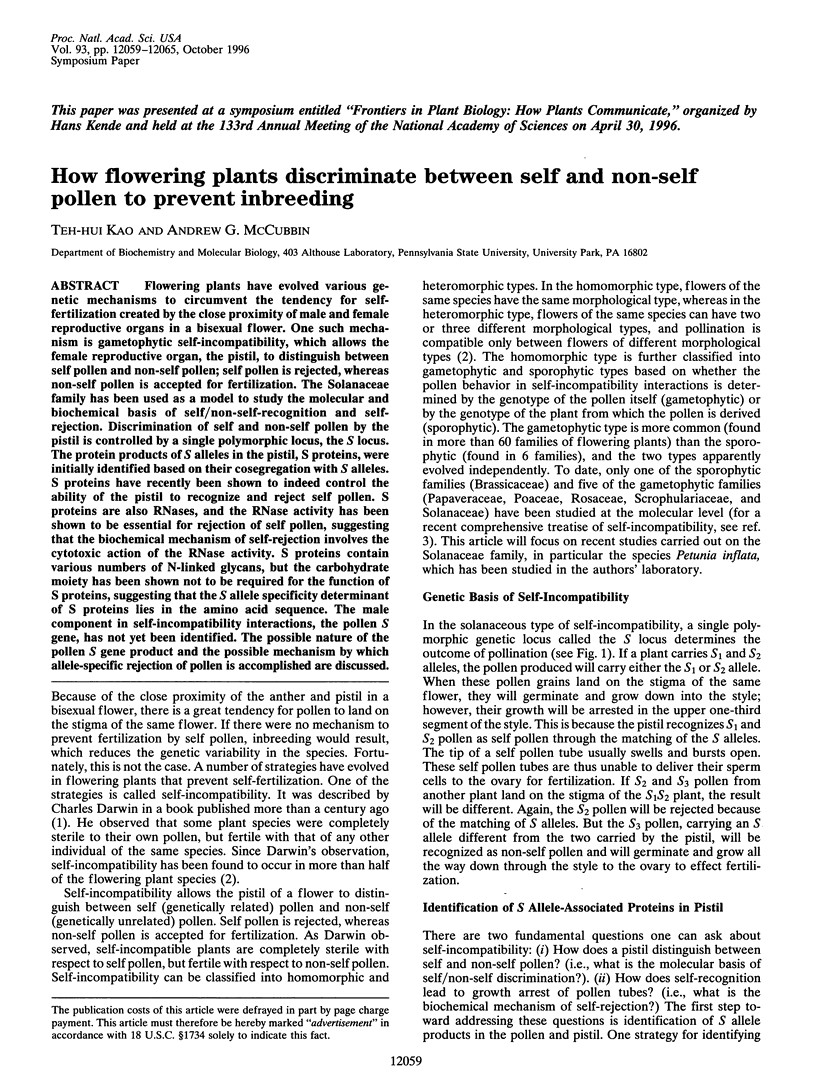
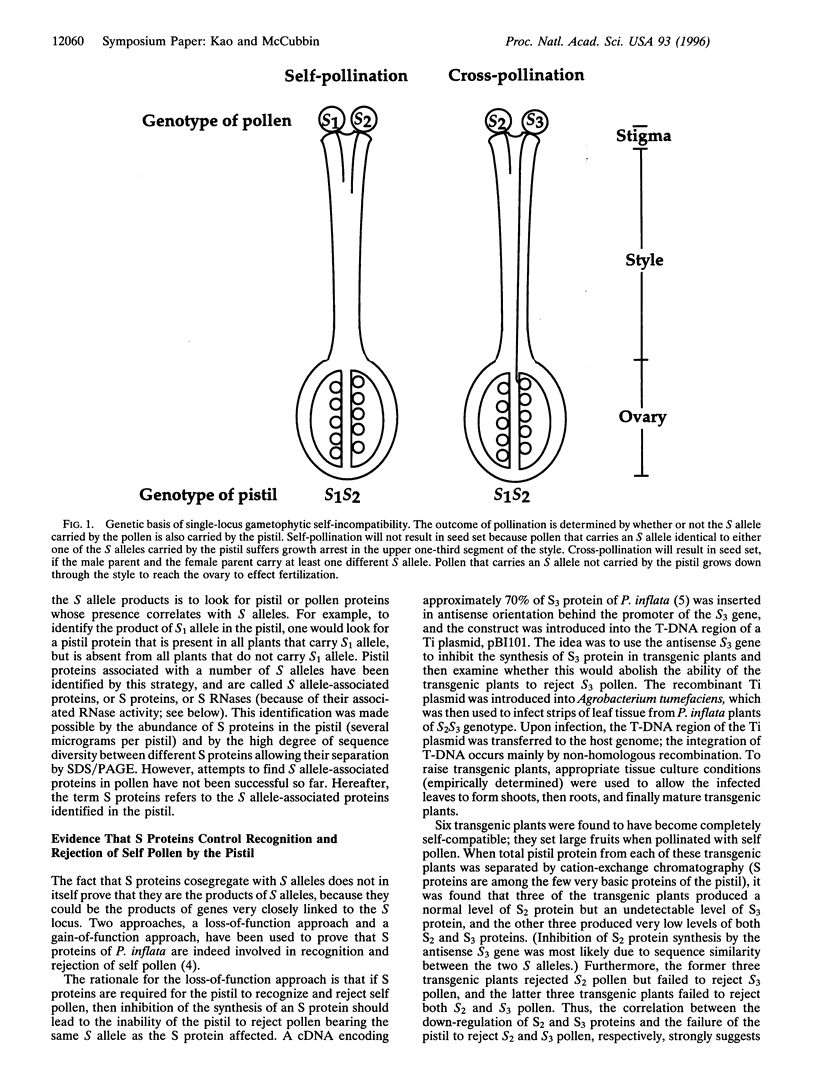

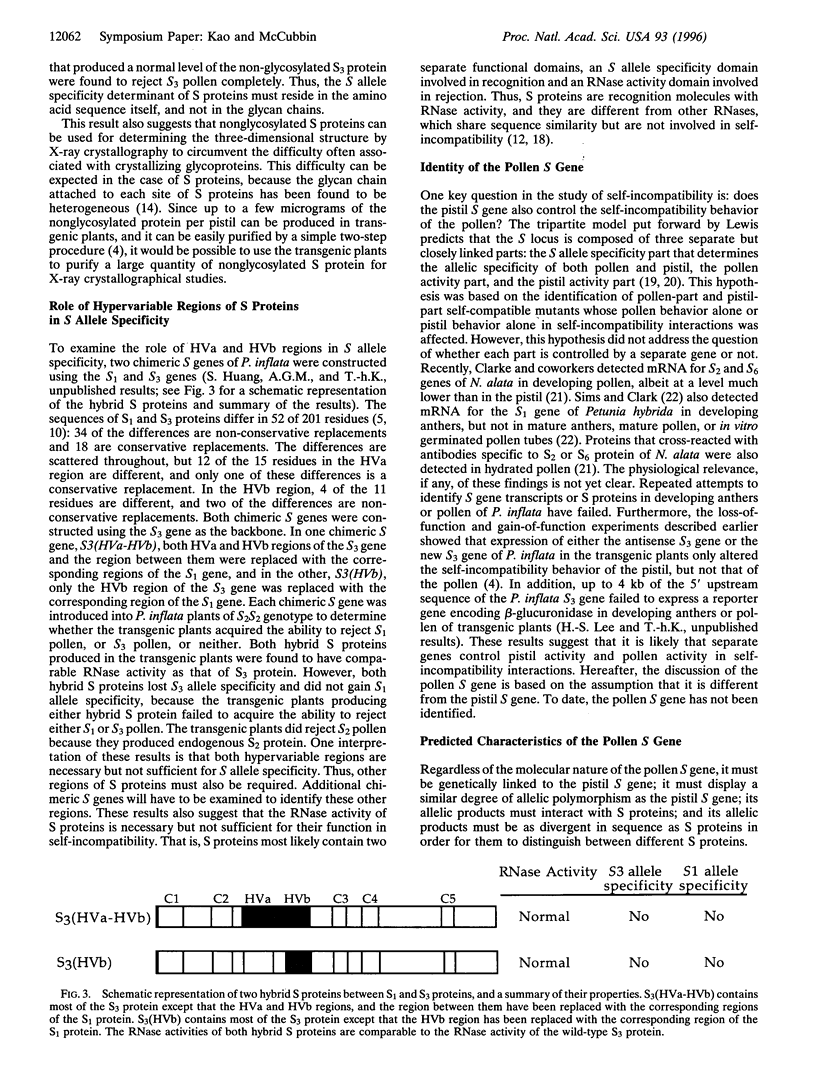
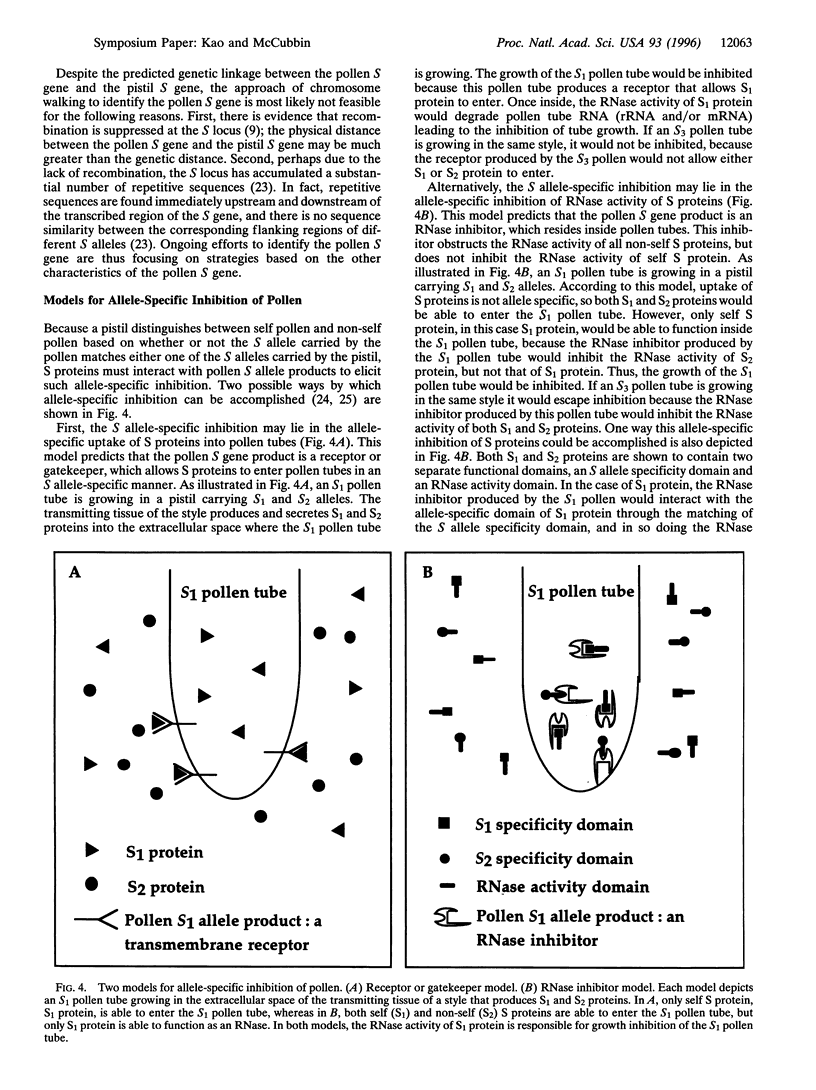
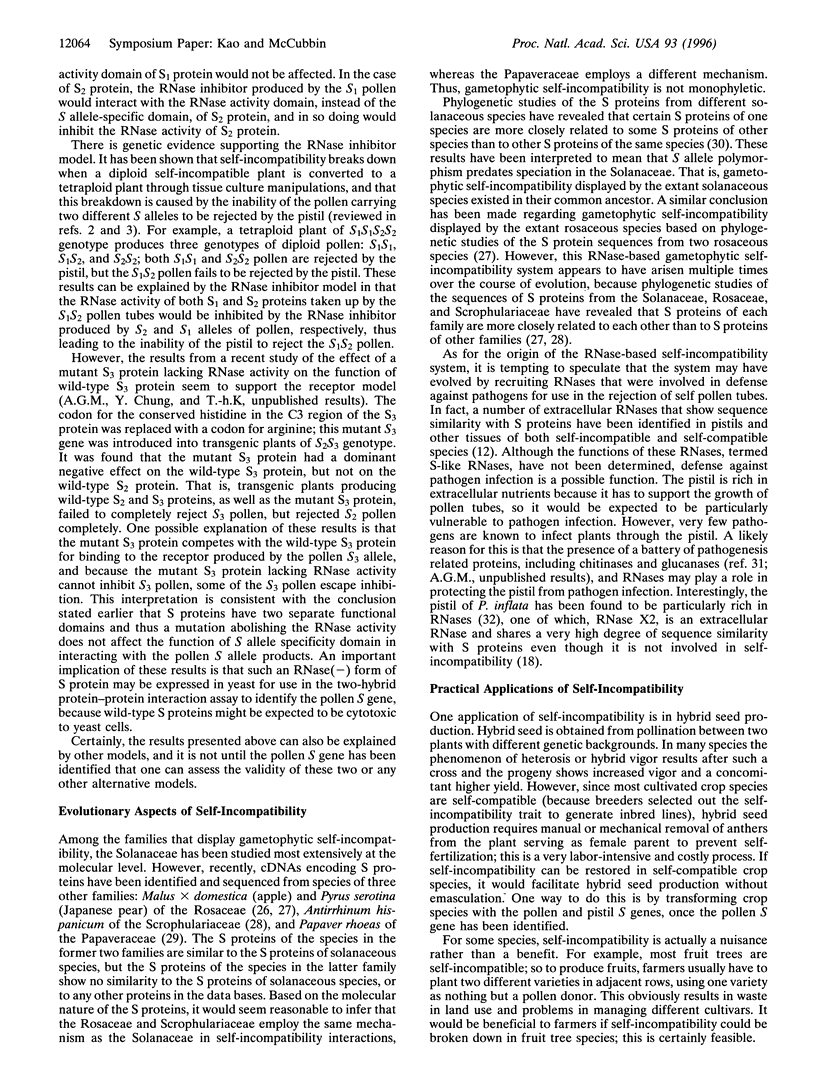
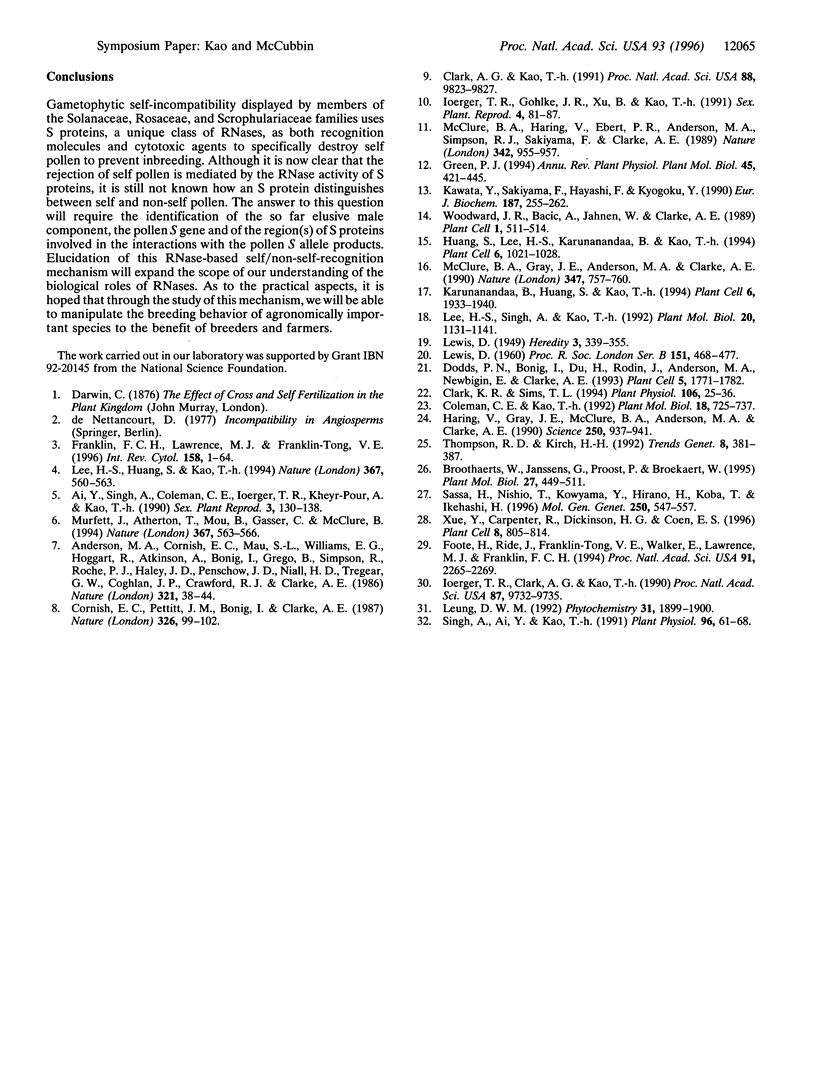
Images in this article
Selected References
These references are in PubMed. This may not be the complete list of references from this article.
- Broothaerts W., Janssens G. A., Proost P., Broekaert W. F. cDNA cloning and molecular analysis of two self-incompatibility alleles from apple. Plant Mol Biol. 1995 Feb;27(3):499–511. doi: 10.1007/BF00019317. [DOI] [PubMed] [Google Scholar]
- Clark A. G., Kao T. H. Excess nonsynonymous substitution of shared polymorphic sites among self-incompatibility alleles of Solanaceae. Proc Natl Acad Sci U S A. 1991 Nov 1;88(21):9823–9827. doi: 10.1073/pnas.88.21.9823. [DOI] [PMC free article] [PubMed] [Google Scholar]
- Clark K. R., Sims T. L. The S-ribonuclease gene of Petunia hybrida is expressed in nonstylar tissue, including immature anthers. Plant Physiol. 1994 Sep;106(1):25–36. doi: 10.1104/pp.106.1.25. [DOI] [PMC free article] [PubMed] [Google Scholar]
- Coleman C. E., Kao T. The flanking regions of two Petunia inflata S alleles are heterogeneous and contain repetitive sequences. Plant Mol Biol. 1992 Feb;18(4):725–737. doi: 10.1007/BF00020014. [DOI] [PubMed] [Google Scholar]
- Dodds P. N., Bönig I., Du H., Rödin J., Anderson M. A., Newbigin E., Clarke A. E. S-RNase gene of Nicotiana alata is expressed in developing pollen. Plant Cell. 1993 Dec;5(12):1771–1782. doi: 10.1105/tpc.5.12.1771. [DOI] [PMC free article] [PubMed] [Google Scholar]
- Foote H. C., Ride J. P., Franklin-Tong V. E., Walker E. A., Lawrence M. J., Franklin F. C. Cloning and expression of a distinctive class of self-incompatibility (S) gene from Papaver rhoeas L. Proc Natl Acad Sci U S A. 1994 Mar 15;91(6):2265–2269. doi: 10.1073/pnas.91.6.2265. [DOI] [PMC free article] [PubMed] [Google Scholar]
- Haring V., Gray J. E., McClure B. A., Anderson M. A., Clarke A. E. Self-incompatibility: a self-recognition system in plants. Science. 1990 Nov 16;250(4983):937–941. doi: 10.1126/science.2237440. [DOI] [PubMed] [Google Scholar]
- Huang S., Lee H. S., Karunanandaa B., Kao T. H. Ribonuclease activity of Petunia inflata S proteins is essential for rejection of self-pollen. Plant Cell. 1994 Jul;6(7):1021–1028. doi: 10.1105/tpc.6.7.1021. [DOI] [PMC free article] [PubMed] [Google Scholar]
- Ioerger T. R., Clark A. G., Kao T. H. Polymorphism at the self-incompatibility locus in Solanaceae predates speciation. Proc Natl Acad Sci U S A. 1990 Dec;87(24):9732–9735. doi: 10.1073/pnas.87.24.9732. [DOI] [PMC free article] [PubMed] [Google Scholar]
- Karunanandaa B., Huang S., Kao T. Carbohydrate moiety of the Petunia inflata S3 protein is not required for self-incompatibility interactions between pollen and pistil. Plant Cell. 1994 Dec;6(12):1933–1940. doi: 10.1105/tpc.6.12.1933. [DOI] [PMC free article] [PubMed] [Google Scholar]
- Kawata Y., Sakiyama F., Hayashi F., Kyogoku Y. Identification of two essential histidine residues of ribonuclease T2 from Aspergillus oryzae. Eur J Biochem. 1990 Jan 12;187(1):255–262. doi: 10.1111/j.1432-1033.1990.tb15303.x. [DOI] [PubMed] [Google Scholar]
- LEWIS D. Genetic control of specificity and activity of the S antigen in plants. Proc R Soc Lond B Biol Sci. 1960 Mar 1;151:468–477. doi: 10.1098/rspb.1960.0010. [DOI] [PubMed] [Google Scholar]
- LEWIS D. Structure of the incompatibility gene; induced mutation rate. Heredity (Edinb) 1949 Dec;3(3):339–355. doi: 10.1038/hdy.1949.25. [DOI] [PubMed] [Google Scholar]
- Lee H. S., Huang S., Kao T. S proteins control rejection of incompatible pollen in Petunia inflata. Nature. 1994 Feb 10;367(6463):560–563. doi: 10.1038/367560a0. [DOI] [PubMed] [Google Scholar]
- Lee H. S., Singh A., Kao T. RNase X2, a pistil-specific ribonuclease from Petunia inflata, shares sequence similarity with solanaceous S proteins. Plant Mol Biol. 1992 Dec;20(6):1131–1141. doi: 10.1007/BF00028899. [DOI] [PubMed] [Google Scholar]
- McClure B. A., Haring V., Ebert P. R., Anderson M. A., Simpson R. J., Sakiyama F., Clarke A. E. Style self-incompatibility gene products of Nicotiana alata are ribonucleases. Nature. 1989 Dec 21;342(6252):955–957. doi: 10.1038/342955a0. [DOI] [PubMed] [Google Scholar]
- Murfett J., Atherton T. L., Mou B., Gasser C. S., McClure B. A. S-RNase expressed in transgenic Nicotiana causes S-allele-specific pollen rejection. Nature. 1994 Feb 10;367(6463):563–566. doi: 10.1038/367563a0. [DOI] [PubMed] [Google Scholar]
- Sassa H., Nishio T., Kowyama Y., Hirano H., Koba T., Ikehashi H. Self-incompatibility (S) alleles of the Rosaceae encode members of a distinct class of the T2/S ribonuclease superfamily. Mol Gen Genet. 1996 Mar 20;250(5):547–557. doi: 10.1007/BF02174443. [DOI] [PubMed] [Google Scholar]
- Singh A., Ai Y., Kao T. H. Characterization of Ribonuclease Activity of Three S-Allele-Associated Proteins of Petunia inflata. Plant Physiol. 1991 May;96(1):61–68. doi: 10.1104/pp.96.1.61. [DOI] [PMC free article] [PubMed] [Google Scholar]
- Thompson R. D., Kirch H. H. The S locus of flowering plants: when self-rejection is self-interest. Trends Genet. 1992 Nov;8(11):381–387. doi: 10.1016/0168-9525(92)90299-j. [DOI] [PubMed] [Google Scholar]
- Woodward J. R., Bacic A., Jahnen W., Clarke A. E. N-Linked Glycan Chains on S-Allele-Associated Glycoproteins from Nicotiana alata. Plant Cell. 1989 May;1(5):511–514. doi: 10.1105/tpc.1.5.511. [DOI] [PMC free article] [PubMed] [Google Scholar]
- Xue Y., Carpenter R., Dickinson H. G., Coen E. S. Origin of allelic diversity in antirrhinum S locus RNases. Plant Cell. 1996 May;8(5):805–814. doi: 10.1105/tpc.8.5.805. [DOI] [PMC free article] [PubMed] [Google Scholar]



